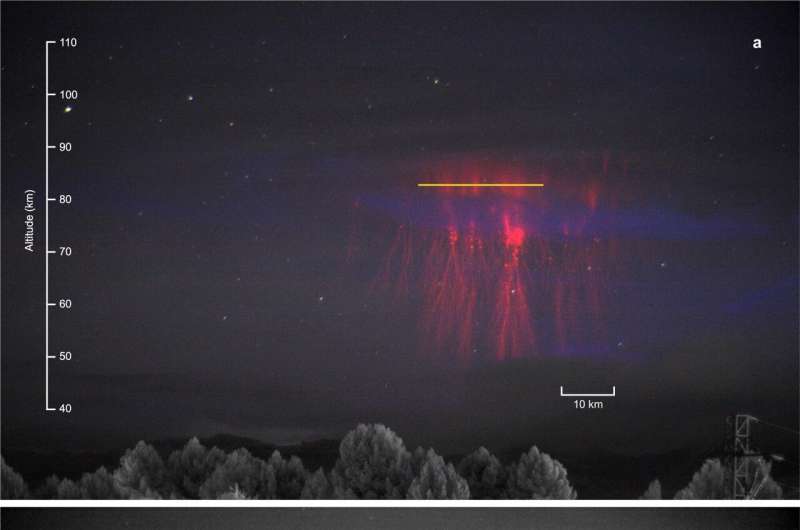December 13, 2023 report
This article has been reviewed according to Science X's editorial process and policies. Editors have highlighted the following attributes while ensuring the content's credibility:
fact-checked
peer-reviewed publication
trusted source
proofread
Spectroscopic data from atmospheric green ghost captured for the first time

A team of astronomers from Instituto de Astrofísica de Andalucía, CSIC, Glorieta de la Astronomía, and Universitat Politécnica de Catalunya has captured spectroscopy data from a mesospheric green ghost for the first time.
In their paper published in the journal Nature Communications, the group describes their years-long effort to capture data that would explain the nature of atmospheric green ghosts and how they finally managed to achieve their goal. The editors at Nature have also published a Research Highlight synopsis of the work done by the team.
Prior research has shown that during some thunderstorms, atmospheric phenomena known as sprites appear above normal types of lightning. Prior research has also shown that sprites are electric discharges, typically displayed as red-orange flashes in various shapes, which means that they are technically another type of lightning. They are known in the science community as transient luminous events (TLE).
In 2019, a citizen scientist named Hank Schyma, while video recording a TLE, found he had also recorded a greenish glow on top of a TLE. He posted his video on YouTube, where it caught the attention of professional skywatchers. Since that time, both amateur and professional videographers have managed to capture the "green ghosts," as they have come to be known. Many had been captured on video prior to Schyma's posting but had not been identified as something new.
After speculation in the scientific community, the consensus was that the green ghosts were likely nothing more than excited oxygen atoms. Unconvinced, the members of the team in this new study set out to capture spectroscopic data from a green ghost, which would show what materials in the atmosphere contributed to its creation.
Because of their rarity, it took the researchers nearly four years to achieve their goal—it came on the night of September 21, 2019, as the team pointed their device at a TLE over the Mediterranean Sea. And while the team was not able to capture photographic evidence of the green ghost, their equipment showed a glow in the green spectrum—it lasted for more than 500 milliseconds, far longer than a TLE.
They found evidence of nickel, iron and nitrogen in addition to oxygen—suggesting that the green ghost resulted from meteoric ablation of interplanetary dust particles moving through the atmosphere at high speed.
More information: María Passas-Varo et al, Spectroscopy of a mesospheric ghost reveals iron emissions, Nature Communications (2023). DOI: 10.1038/s41467-023-42892-1
Where 'green ghost' lightning gets its emerald hue, Nature (2023). DOI: 10.1038/d41586-023-03810-z
Journal information: Nature , Nature Communications
© 2023 Science X Network





















